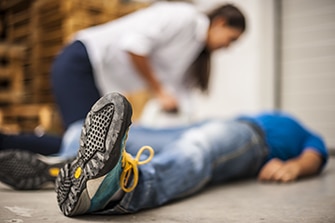What Are Opioid Overdose Signs?
On average, 130 Americans die from an opioid overdose every day. The Centers for Disease Control and Prevention (CDC) considers opioid overdose an epidemic in the United States, estimating it responsible for nearly 68 percent of 70,000 drug-related deaths in 2017. Understanding the effects of opioids can prevent opioid overdose, and knowing the opioid overdose signs can save lives.
What Are Opioids?
Opioids are a class of drugs naturally found in the opium poppy plant. Opioid drugs reduce pain by binding to opioid receptors in your brain, spinal cord and other areas of the body, creating morphine-like effects.
The CDC identifies these opioids as the most commonly used:
- Prescription Opioids. Prescription opioids, such as Oxytocin and Vicodin, are prescribed by doctors to treat moderate to severe pain but can have serious risks and side effects.
- Fentanyl. Fentanyl is a synthetic pain reliever much stronger than other opioids (50-100 times more potent than morphine) and is approved for treating severe pain, like cancer pain. In several states, there’s been an increase in illegally produced and distributed fentanyl.
- Heroin. Heroin is an illegal, highly addictive opioid synthesized from morphine. Heroin use has increased sharply across the United States, with the greatest increases occurring among demographic groups with previously low rates of use: women, the privately insured, and individuals with higher incomes.
What Happens During an Opioid Overdose?
It can be difficult to determine whether an individual is experiencing a drug high or an opioid overdose – but when in doubt, err on the side of caution. Due to their effect on the part of the brain that regulates breathing, opioids in high doses can cause respiratory depression and death. The ability to quickly recognize an opioid overdose can reduce a fatality.
The Harm Reduction Coalition lists the following signs as symptoms that someone is high (not necessarily overdosing) on downers like heroin or pills:
- Slack and droopy muscles
- Nodding in and out of consciousness
- Excessive scratching due to itchy skin
- Slurring speech
- Out of it, but still responding to outside stimuli like loud noises or physical contact
If you’re concerned a friend is getting too high, keep an eye on them. Don’t leave them alone. Keep them awake by walking around and monitor their breathing.
Three main signs of opioid overdose
These three main signs of an opioid overdose are collectively referred to as the opioid overdose triad. They include:
- Pinpoint pupils (i.e. contracted and small)
- Respiratory depression
- A decreased level of consciousness or unconsciousness.
When an individual is experiencing an opioid overdose, the following signs will also be noticeable:
- Loss of consciousness
- Inability to talk despite consciousness
- Unresponsive to outside stimulus
- Slow, erratic, or halted breathing
- Choking sounds or gurgling noises
- Vomiting
- Very limp body
- Pale, clammy face
- Skin tone turns bluish purple (for paler complexions) or grayish (for darker complexions)
- Lips and fingernails turn blue or purplish black
- Heartbeat is slow, unstable, or nonexistent.
What Increases Risk of Opioid Overdose?
Adults between the ages of 25 and 54 years old have the highest rates of opioid overdose deaths. In 2017, the CDC reported that more than 15,000 individuals died from drug overdoses involving heroin in the United States. That’s almost 5 deaths for every 100,000 Americans.
Nonfatal overdoses are several times more common – a 2017 study published by the U.S. National Library of Medicine found that about 45 percent of drug users will experience nonfatal overdose and about 70 percent will witness drug overdose (both nonfatal and fatal) during their lifetime.
Individuals have an increased risk of an opioid overdose if they:
- Are taking higher doses of prescription opioids.
- Inject opioids.
- Use opioids and have medical conditions such as HIV, liver or lung disease.
- Use opioids and suffer from depression.
- Combine opioids with other sedating substances.
- Live in a household with individuals in possession of opioids.
Research shows that individuals who have had at least one non-fatal overdose are more likely to have another.
Preventing Opioid Overdose
The Substance Abuse and Mental Health Services Administration recommends the following strategies to prevent opioid overdose deaths:
- Learn how to treat and manage opioid overdose.
- Have access to a Naloxone rescue kit [https://prescribetoprevent.org/].
- Get treatment for your existing substance abuse disorder.
- If you suspect an overdose, call 911.
About Cliffside Malibu
Knowing the opioid overdose signs are extremely helpful in saving the life of a loved one suffering from addiction. So is helping them to get the treatment they desperately need. If you or someone you love is suffering from an addiction to opioids, Cliffside Malibu can help.
Since no two addictions are the same, Cliffside Malibu offers an individualized treatment plan for every client. We are committed to providing evidence-based treatment through a continuum of care model including medically supervised detox, residential treatment, day treatment, and outpatient services. Our program also includes family therapy and holistic therapy, as well. Whether an individual is suffering from substance abuse and/or alcohol addiction, our programs are structured to create a supportive environment where healing can begin.
In addition to world-class treatment, Cliffside Malibu offers luxury accommodations, a serene environment, five-star dining, and plentiful amenities. We understand that addiction treatment is a rigorous process. Therefore, we provide for your comfort and relaxation at every turn, allowing you to rejuvenate, and meet the demands of treatment with your greatest energy and attention.
For more information on Cliffside Malibu, visit cliffsidemalibu.com
